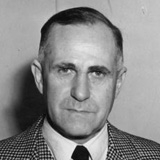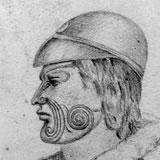Hone Heke
Bay of Islands Ngā Puhi chief Hone Heke was an influential Māori voice in favour of the Treaty of Waitangi. However he later became a leading opponent of British rule in New Zealand.
Heke, a Christian, had a close relationship with missionary Henry Williams, and, at the signing of the Treaty in 1840, he believed Williams' assurances that the authority of Maori chiefs would be protected.
'Governor,' he told Hobson, 'you should stay with us and be like a father. If you go away, then the French and the rum sellers will take us Māori over.' The following day, he was the first of more than 40 northern chiefs to sign (although his signature is fourth, those of more senior chiefs having later been inserted ahead of his).
Four years later, disillusioned by the failure of colonialism to bring his people economic prosperity and by the increasing control of the British government over Māori affairs, Heke ordered the cutting down of the flagpole at the British settlement Kororāreka (later renamed Russell). This was intended to show displeasure at British government, yet not threaten the Pākehā settlers. Over the following months, it was re-erected and cut down again three times. In 1845, this protest action resulted in war between British troops and northern Māori.
- Find out more: biography of Hone Heke on the DNZB website
Hone Heke (Hone Wiremu Heke Pokai)
He rangatira a Hone Heke nō Pēwhairangi, nō Ngā Puhi (? -1850). He tino reo rongonui, he reo whai mana, he reo i tautoko i te Tiriti o Waitangi. Ahakoa, ka huri ia i muri hei tino pou whakahē i te mana whakahaere o Ingarangi ki Aotearoa.
He Karaitiana a Heke, ā, he hoa piri tata tonu ki a Te Karuwhā. I te hainatanga o te Tiriti i te tau 1840, koia tētahi i whakapono ki ngā kī taurangi a Te Karuwhā tērā tonu e tiakina te mana o ngā rangatira Māori.
“E te Kāwana,” te kī a Heke ki a Te Hopihona, 'me noho mai koe ki a mātou, ānō he matua atawhai. Ki te wehe atu koe i a mātou, ka riro tō matou mana i te Wīwī, i ngā kaihoko rama hoki.' I te rā o muri mai, ko ia te tuatahi o ngā rangatira 40 neke atu o Te Tai Tokerau ki te haina (ahakoa ko tōna moko te mea tuawhā i te Tiriti ina pānuitia, i te mea i whakaurungia ngā hainatanga o ōna rangatira ki runga ake i tāna).
Ka pā te pōuri me te mamae ki a Heke i te whā tau i muri mai, nā te mea kāore te whakatū koroni i whakawātea i ngā huarahi oranga mō te iwi, ā, i te whakangaromia e te Karauna o Ingarangi te mana o te iwi Māori. Ka tono a Heke kia topea te pou haki i te kāinga Pākehā o Kororāreka. Ko te take i pērā ai, he āta whakaatu i tō rātou riri ki te mana kāwanatanga o Ingarangi, engari kia kaua e whakatumatuma ki ngā kaiwhakanoho Pākehā. I roto i ngā marama whai muri, e toru atu anō ngā whakatūranga me ngā topenga i te pou. I te tau 1845, i te topenga tuawhā, ka pakanga a Ingarangi ki ngā iwi o Te Tai Tokerau.
was he born in 1807?





 del.icio.us
del.icio.us Facebook
Facebook Google
Google StumbleUpon
StumbleUpon Twitter
Twitter







Community contributions